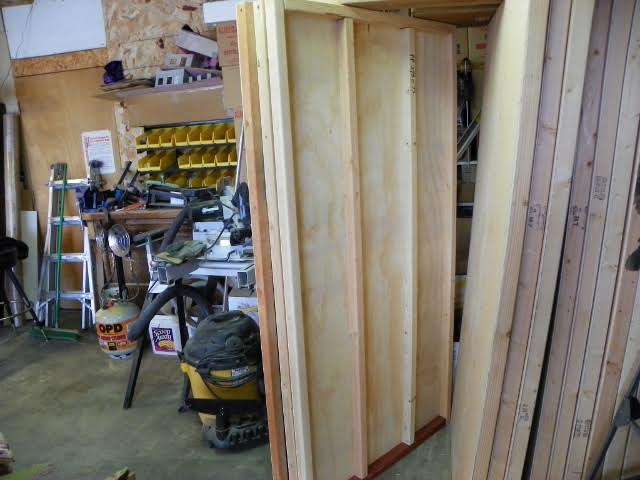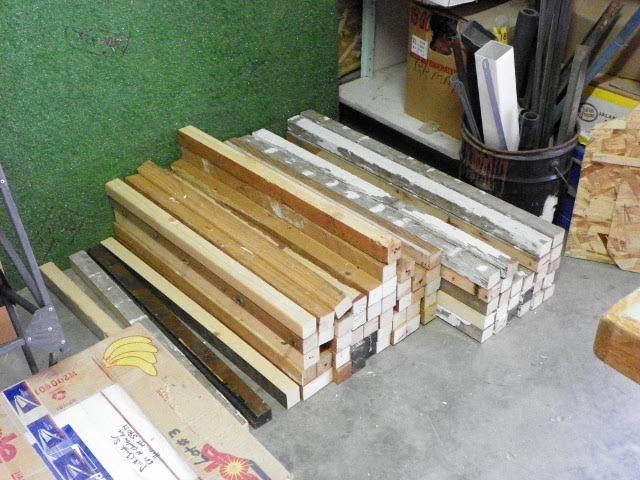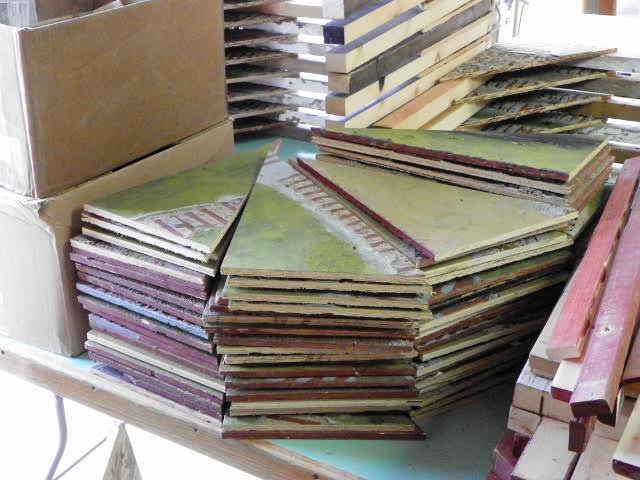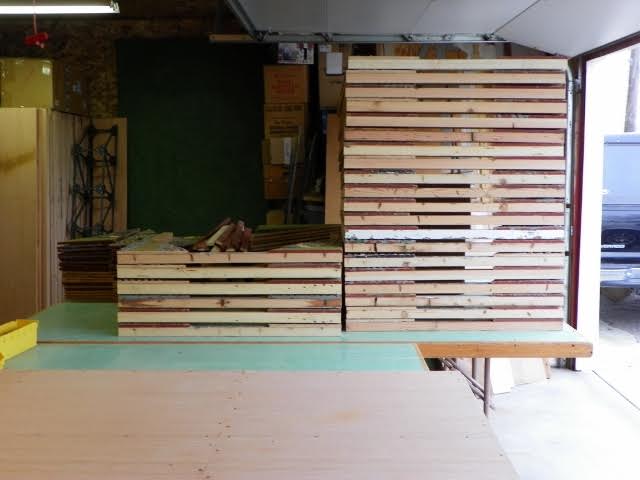Dick’s been in touch with his indoor G scale layout:
“Al:
As mentioned before, I decided upon using 3′ by 6′ tables as standard.
24 tables were made. I precut all required 2 by 2’s for perimeter frames, cross braces, legs, and leg wings.
All holes for screws that attach leg assemblies to the tables are pre-drilled in the exact same spots so the leg assemblies are interchangeable. Only 2 crew sizes are needed.
I hate to waste lumber, so I figured in all of my cuts to use up every last bit of wood I had.
All framing is glued as well as screwed together. The result is lightweight tables that are strong enough to support my weight along the edges and centers of each table.
Should the need arise to actually climb up on top of the tables I lay a thicker mat of plywood or 2 by 8’s or whatever on the tables to rest my hands and knees on.
Just like using dominoes, I can make most any configuration with these tables.
When the tables are in place, then short metal bars are used to tie the tables together as can be seen in the photos.
The tables are kept sandwiched together by using simple metal strips connecting adjoining tables.
Each table is identified as table 1 through table 24. Each table has a North end and a South end labeled.
Each leg assembly is also labeled with table number and North or South.
Even though the leg assemblies will interchange with the tables I found slight variations so decided to number the legs as well.
Next came the scaled detail diagram showing table layout, and table orientation, I plotted a track diagram that would fit nicely, then using my diagram as a guide, I then drew the layout in pencil on the tables.
Next came the track sections to match the layout center lines drawn on the tables.
After all track was in place, I labeled each track section and marked it out on the table also so I would know where each section went each time the track was assembled and taken apart.
The roadbed was then painted on which looks very good really, using a mixture of paints and stippling them on for a 3-d effect.
More pictures to follow will show the simple painted on rivers, some greens and browns. The majority of the tabletops were left bare as they already have a fairly nice earth color to them.
Wiring is kept very simple, all wiring laid on top of the tables, no permanent under table wiring to snag. Wiring on top is easy to disguise when necessary.
For this layout all curves are 8′ diameter and 10′ diameter with many 20′ diameter curves tossed in also. turnouts are all #6 Aristocraft switches.
Next up will be some discussion on era chosen, some scenes of Crow Agency Mt which is on the Crow Indian Reservation.
Thanks again Al.
I will work up part 4 next, after a couple days here when I have more time.
Dick Chapple Sr”
Indoor G scale:
A huge thanks to Dick for sharing his indoor G scale. It’s funny how what you choose to make your layout on is so important – it affects so many things.
Make your layout table too low and you’ll end up with a lot of back ache, and of course, getting underneath the table is also a problem. But at least the little people can enjoy the trains too.
Making your table higher means it’s easier to get under it for the wiring – but then reaching the middle of it gets to be a pain the backside. And the little peeps won’t be able to see so much of it. And of course, derailments can whizz of the side of the table which sometimes becomes expensive.
In fact there are lots and lots of posts on this subject – because it really does have a huge bearing on your layout. Here’s one from Rob that proves the point…
That’s all for today folks.
Please do keep ’em coming.
And if today is the day you get started on your layout, the Beginner’s Guide is here.
Best
Al
PS Latest ebay cheat sheet is here.
PPS More HO scale train layouts here if that’s your thing.











You guys need a fire station.
Great to see something on G Scale. would have liked a better pic of the actual layout. My G scale uses 6 by 8 ft sections pushed to together and then attached. now in L shape.. track down and working on a tunnel, lake etc
Impressive to see somebody working on a large canvas. G scale certainly gives the opportunity to build detail into a layout.
Very nice. We love our trains. Keep it up.
layouts,new house and car to buy, websites to develop, new company to build, there is a thousand things I want to do at 51 plus my wife requires constant attention! I am thankful you guys keep sending me plenty of true eye candy for adults still crazy about model railroading. Keep soaring and sending pictures of your layouts. I enjoy the big versatility of G scale and I enjoyed spying the old relic full scale abandoned rail cars. They look so lonely and in need of our team of TLC guys. Keep up the great work and keep sending me pictures.
Nicely done!
Nice to see ‘G’ done on a larger scale (no pun). Great job Dick! G scale is also a great outdoor railroad experience as well.
Thanks Al for publishing my work, glad you found them. I do have more information to share. We had set this display up in the waiting room of the CB&Q railroad station. It ran flawlessy, we had lots of visitors and excellent comments on the track layout .
Honestly I don’t remember if I sent in overview pictures and a track diagram so I will do that. all the wood is recycled from an earlier G scale layout except for the table tops.
Thanks for the comments too folks.
Dick in Montana USA
If nothing else that is one hell of a train room to have.
Wow! Where is this located. I’d like that room for half shop and half trains. 😎
Wow…
Solid work.
Wow Looks great. But would like see more.
So how high is that table shown above?
WOW Impressive.
Large scale in so many ways! Neat idea about wiring on top and disguising with scenery. I mean… why not?